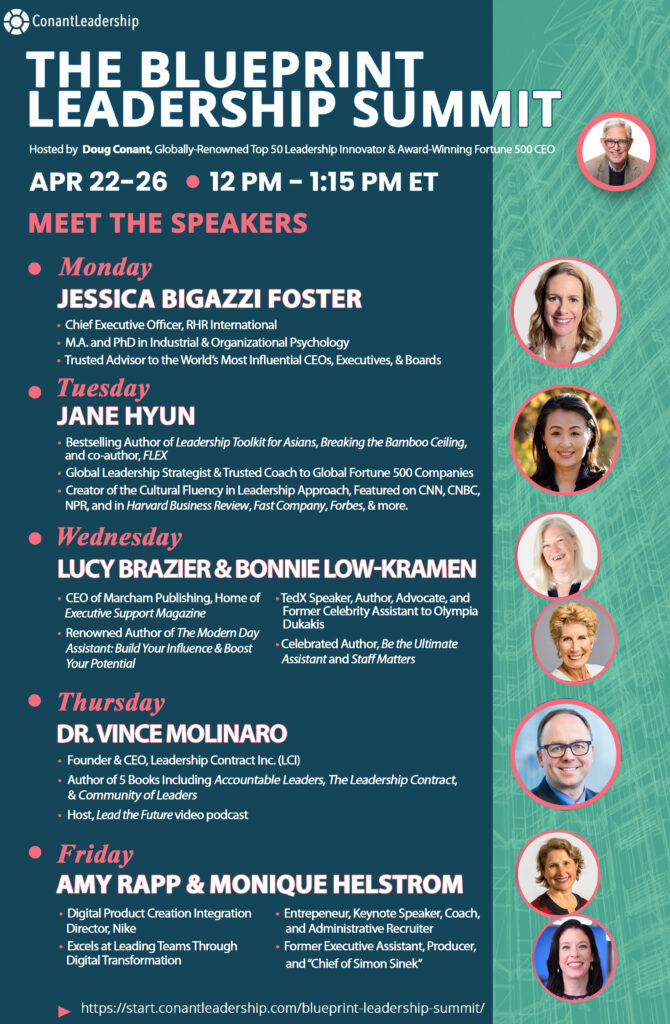At ConantLeadership, we’re committed to lifelong learning and continuous improvement. In service to your leadership growth, each month we curate the Leadership That Works Newsletter, a digest of timely resources from around the web. We prepare this resource in order to:
- Share actionable advice from top leadership luminaries
- Celebrate a range of viewpoints (inclusion is not an endorsement)
- Contextualize workplace trends through a leadership lens
- Illuminate cultural recalibrations in the world of work
- Support your personal development in life, leadership, and beyond
In this month’s Leadership That Works Newsletter: Don’t avoid tough topics, 4 questions to jumpstart culture change, how to sell your ideas, the difference between analysis and understanding, why ‘transformational’ leadership is better than ‘transactional’ leadership, and more. As always, we’re sharing the content from our newsletter here on our blog in case you’re not subscribed to our mailing list. If you find these links enriching, you can sign up to receive our newsletter right here.
Avoiding Tough Topics Causes ‘Fake Harmony’
4. Keep the goal in mind. “Do you just want to be heard, or do you want to accomplish something specific? Your approach should reflect your desired outcome.”
5. Don’t forget to outline next steps. “Leave the conversation with a clear plan, so the gains made during the talk don’t fizzle out.”
Get the full story, including Wing’s advice for what to do when conversations go off the rails, here.
4 Questions to Jumpstart Culture Change
- What is the scope of the change required?
- What does the future state look like?
- What are the root causes behind the behaviors you need to change?
- What behavioral science-based “nudges” can you use to help employees and leaders break old habits and form new ones?
Get the full story here.
**For more on this, explore our coverage of Doug Conant and Indra Nooyi’s conversation about how to be a transformational leader.
How to Overcome ‘Bias against Creativity’ to Sell New Ideas
A body of research covered in this Contagious interview with scholar Wayne Johnson, who studies why humans embrace or reject ideas, shows that people tend to view novel or creative ideas less favorably. One reason for this “bias against creativity” is that new ideas often generate more disagreement than tried-and-true approaches, and stakeholders view discord as a “bad signal” of how useful an idea is likely to be, regardless of its merit.
Johnson explains that the greater the “novelty,” defined as the “distance from a reference point” an idea is, the more difficult it is for people to accept: “Absolute novelty would be something that nobody has ever seen; relative novelty is something that I haven’t seen.” He says leaders can overcome the obstacle of bias, and persuade more people, by choosing a familiar reference point in their communications: “You see entrepreneurs do this all the time, ‘This is the Uber of pet food,’ etc.” And when you receive “mixed feedback,” don’t give up. Johnson says ambiguous responses are not a sign to throw in the towel, they are a prompt to get curious and “dig deeper,” to ask more questions, address constituent concerns, and earn buy-in. Get the full story here.
‘Transformational’ > ‘Transactional’
In a recent keynote speech covered in this Healthcare IT News piece, retired University of Alabama football coach Nick Saban, who led his team to six national championships, shared why “transformational leaders” are “much more effective” than “transactional leaders.” Saban recalls his own story about changing his leadership style; he used to be purely “results-oriented,” which meant “winning the game was most important, not how you played the game.” In this transactional mode, he was supportive when players won, “but if we lost? I was very critical. It was always somebody’s fault.”
Saban began to change one season when his team, with an average record, had to face off against an undefeated team. He worried, “How are we going to win this transaction, when I think we have no chance?” A psychiatrist advised him to tell the players to take the game “one play at a time,” to coach them through it in a “very process oriented way,” focused not on the outcome itself, “but what would you have to do to get the outcome.” It was an alien approach to Saban, but it worked: Against all odds, his team achieved victory over the superior opponent. He says, “I became a transformational leader from that moment on,” which requires setting a good example and helping people “for their benefit, not your benefit.” Saban adds that people-focused leadership means: “You care. You have a vision, you have a plan. You’re willing to inspire and teach them everything they need to do to be the best version of themselves.” Get the full story here.
**For more on this, explore our post from the archives, “How to Influence People with Honor.”
Don’t Predict What Will Change; Predict What Will Stay the Same
In an effort to remain competitive for the foreseeable future, many leaders try to predict what will change, prognosticating what’s coming down the pipe, and trying to adjust accordingly. Shane Parrish, in this Farnam Street post, explains that the instinct for prediction is understandable and universal: “Everyone speculates on what the future holds. The question, ‘What’s going to change in the next 10 years?’ is popular in nearly all industries.” The problem, he says, is that “our desire to know the future leads us to answer questions that are impossible to answer,” and worse, “we’re almost always wrong.”
Parrish laments that “all the effort that goes into unknowable questions comes at the expense of things we can know.” So he urges leaders to engage in a reframe: “While it’s fun to guess what will change in the future, a more important question is ‘what’s not going to change in the next ten years?'” Focusing on what’s likely to remain the same helps you “position yourself for multiple possible futures,” rather than planning for only “one version.” For example, “While you don’t know when a financial panic is coming, you know one will come. While you don’t know what job you will hold in the future, you know you can increase your value by learning more skills,” and so on. It may be that the best strategic advantage comes from “positioning over predicting.” Get the full story here.
Seek to Understand, Not to Analyze
Business leaders love data, but often struggle to convert information into effective action, says Executive Coach Dave Coffaro in this SmartBrief piece on decision making. He writes: “Companies gather gigabytes of customer data, employee engagement insights, and the latest industry-specific technology trend details,” but then “fall short of translating this information to evolve their go-to-market business models.” Why this gap between input and output? Coffaro says, “often, the answer is confusing analysis with understanding.” It’s an important distinction. He defines analysis as “the process of breaking something down to understand its elements,” an exercise which, while useful, can be myopic on its own. Seeking to understand, rather than analyze, is more powerful because, Coffaro says, it requires deeper engagement with the available information: “Understanding is the ability to grasp the complete picture and cause-and-effect relationships in a meaningful way.” Leaders armed with understanding are better equipped to make strategic decisions; they see how the data impact “today’s operating environment,” and anticipate “how changes unfolding now” will affect tomorrow. Get the full story here.
The Secrets to Mastering Resilience
In this Chief Executive article, Eric Potterat, PhD, and Alan Eagle, coauthors of the book Learned Excellence, write: “Resilience is the ability to withstand, recover and improve from adversity,” and “it is a critical component of excellence.” They say their experience working with the world’s “best athletes, business leaders, military operators and first responders” has shown them that the secret to mastering resilience is in a “mental approach” that is not innate, but developed: “Top performers learn excellence.” So how can leaders practice, teach, and “inspire resilience in their teams?” Potterat and Eagle offer a few landmark principles.
1. Stay in the circle. “In the circle are the things you control: your attitude, effort, and behavior. Everything else is outside the circle.”
2. Ignore stuff outside the circle. “Ignore what other people are saying,” ignore “external factors,” and ignore your competition because “all of these things are outside your control.”
3. Practice, practice, practice. “One reason top athletes and entertainers are so good at resilience is that they have plenty of opportunity to practice.” Leaders should provide the same for their teams: “Create an environment where it’s okay to try solving old problems in new ways,” and learn from mistakes; the more you practice, “the more it will become habit.”
Get the full story here.
Cracking the Agility Code
“Everybody wants agility,” but it seems like “nobody actually has it,” writes Ed O’Boyle in this Gallup post on how to make organizations more nimble and effective. One issue is that agility is misunderstood. Research shows “what agility really defines is a desire—a desire to move faster, change faster, and deliver faster in response to a marketplace that is moving, changing, and demanding more than ever before.” O’Boyle says leaders are poised to deliver on that desire when they understand the “three biggest challenges to agility.”
1. Ambition colliding with the matrix. “In most workplaces, every person is juggling an ambitious to-do list,” and most employees “are matrixed to some extent,” meaning that priorities are often mismatched across the organization. To address this, “leaders must ensure alignment of priorities across teams.”
2. Decision-Making Too Far from the Customer. “Agile workplaces focus on and prioritize creative solutions for the customer.” If associates “have to ask 20 people for approval first” to meet customer needs quickly, that’s a problem. “Leaders should identify decision points,” and empower employees to make customer-focused adjustments.
3. Waiting for “Perfect.” “Fear of not being perfect can lead to endless cycles of minor improvements or repeated checks for validation from leaders.” This slows everything down. Instead, “embracing the concept of ‘minimum lovable product’ encourages teams to release imperfect” but quality products and invites continuous iteration and improvement.
Get the full story here.
**For more on this, explore The Blueprint, a practical process for immediately lifting your impact, which is anchored in small, incremental steps and the rallying cry, “Forget Perfection.”
Insights & Resources from ConantLeadership
 Meet the Speakers for The BLUEPRINT Leadership Summit
Meet the Speakers for The BLUEPRINT Leadership Summit
Full agenda here.
52 Quotes about Trust and Leadership
Given the importance of trust, especially today, it comes as no surprise that this roundup of trust quotes has been one of our most popular posts of all time. So we’ve updated the piece as an “encore” with five new bonus quotes from ConantLeadership Founder, Doug Conant.
‘Take Just One Step’—Debra Benton & Doug Conant on Leadership Courage
In this blog resource from ConantLeadership, two leadership experts impart advice for challenging your assumptions, leading with courage, and taking small steps that push you out of your comfort zone.
‘It’s a Voyage of Joy’—Two Top CEOs Say Optimism & Courage Are Key to Shaping the Future
In this blog resource from ConantLeadership, hear from two top CEOs who say optimism and courage are the key leadership competencies for shaping the future.
February’s Leadership That Works Newsletter
In last month’s newsletter: Live your values, future-proof your leadership mindset, practice ‘growth-oriented’ accountability, speak to ‘educate’ rather than ‘impress,’ get your leadership groove back, and more.
 About the Author: Amy Federman is ConantLeadership’s Director of Content and Editor in Chief, and co-author with Doug Conant of the WSJ bestseller, The Blueprint.
About the Author: Amy Federman is ConantLeadership’s Director of Content and Editor in Chief, and co-author with Doug Conant of the WSJ bestseller, The Blueprint.
(Cover photo by Nick Fewings on Unsplash)






0 Comments